Learn about the basic of battery power for camping
I have been putting off writing about the basics of battery power for camping for a couple of weeks now, it’s a subject that I know I need to know about… but it’s been quite confusing and I’m not sure I have the whole picture. Actually I know I don’t have the whole picture yet because I’m still confused and I don’t know what I need!
If you’re like me and your brain starts to hurt whenever you start reading things like ‘deep cycle battery’, ‘inverter’, ‘anderson plug’, ‘amp hours’ or ‘watt meter’, then hopefully this post is helpful to you.
I am quite sure that you could walk into any of the camping stores or reach out to them online and they’ll tell you exactly what you need, but then if it stopped working, I wouldn’t have the foggiest idea of what was wrong… not much help if you’re in the middle of nowhere. And when you’re buying used (like we are) some set-ups already have a battery powering LED lighting & a water pump for the tap, and they talk about throwing in the solar panel for free… but I don’t know if that’s enough battery for what we need and once again, if it stops working how will I know what’s wrong?
I don’t expect to become an electrician, but I would like to know the names of each of the components and what their job is. So this post is a BEGINNER GUIDE covering only the basics of battery power for camping, to help put all the names and pieces of equipment into context.
Disclosure: there are some affiliate links below. Please see the affiliate disclosure for more information.
Every Batter Power Set-up is Different
To start with, we need to understand that EVERY set-up is different.
We all have different cars, campers, fridges and numbers of electronic devices. Your travelling party may be just you and your spouse, while others may include children. Some people are paleo eaters, some vegetarians, and some people MUST have ice-cream while on their trip. Some people are digital nomads and rely on their devices to run a business while travelling.
Oh, and we all have very different budgets! Obviously you need to keep this all in mind when researching for the best battery power for camping set-up. This is why it’s impossible to find a ‘this-is-what-you-need-to-do’ solution on the internet (yep, I’ve tried) simply because every solution will be different. Okay, you get the point.
To begin with I think it will be helpful to know what we think our set up is going to be:
- Mid-size 4WD SUV or ute towing a camper trailer. Both will be bought used
- We expect the camper trailer will not have battery / lights or anything (although some do)
- These are the electrical things we’ll need to power:
- Fridge
- LED lights in the tent
- Water pump to the sink (if it’s already got one)
- Charging of two laptops, two phones, two tablets and camera equipment (the camera situation is unknown at the moment, but will probably be something like a GoPro and a 360° camera)
- We don’t expect we’ll be driving every day so we will need solar panels to charge the batteries
How to get power when camping
In a nutshell it’s your battery that powers the things like your fridge, lights and charging your electronic devices.
Of course, the battery will only last for a certain amount of time before going flat. So you can re-charge your battery by driving, solar panels or using a battery charger hooked up to mains.
I’m going to go through each of these to explain all the different terms and phrases that are used.

1. Battery – Deep-Cycle Battery
Can you use the battery that’s already in your car, the one that’s used to start the car? No
 You need another battery that is a deep-cycle battery. You may hear this referred to as an auxiliary or secondary, or a dual battery system. This is the battery that will be used to power the fridge, lights, devices etc.
You need another battery that is a deep-cycle battery. You may hear this referred to as an auxiliary or secondary, or a dual battery system. This is the battery that will be used to power the fridge, lights, devices etc.
A deep-cycle battery is a lead-acid battery designed to be regularly deeply discharged using most of its capacity. In contrast, starter batteries (e.g. most automotive batteries) are designed to deliver short, high-current bursts for cranking the engine, thus frequently discharging only a small part of their capacity. Thank you Wikipedia.
There are different types of deep-cycle batteries, but the most commonly used type in Australia is the AGM (Absorbed Glass Mat) battery.
You may have heard about how lithium batteries are becoming more and more popular as they are more efficient, lighter (in weight) and last a lot longer. Buy they are also much more expensive so I’m not going to go into them here. If you’d like to read up some more on them, I found this article gave quite a good overview.
This deep-cycle battery can be fitted under the bonnet of some cars (they have a space already available) or they can be fitted into the cargo area of your car or in the camper trailer/caravan.
What do the different sizes mean?
The battery size is determined by the Amp Hours (Ah) of the battery. If the battery is 100Ah, this means that you have 100 Amp Hours of power available (theoretically).
If you have power consumption of 10 amps per hour (for example, you’ve got a fridge that uses 5 amps of power per hour, lights that use 2 amps per hour and other devices that are using 3 amps per hour) then that means the battery will last for 10 hours before it is completely flat.
Unfortunately it doesn’t quite work like that, AGM batteries should only be discharged about 60-80% before you need to recharge them again. But the Amp Hours is a good way of defining the size of a battery.
If you need a battery, they can be bought online (but thankfully, here in Australia) from: MyGenerator.com.au/camping-rv-batteries
Now let’s talk about how a battery is recharged.
2. Recharging by Driving
Your deep-cycle battery can be charged by being hooked up to the start battery in your car, which is charged up by the alternator when you’re driving.

If you’ve heard of things like a DC-DC charger or VSR (Voltage Sensitive Relay) these are pieces of equipment that go between your car’s start battery and the deep-cycle battery, this is to make sure that the battery is charged enough, but not too much and to make sure that the start battery never gets drained.
I would recommend you watch this video by the guys at Australian Direct. The whole video is really good and very informative, but if you just want to see the bit about charging from your car, then watch from 8:05.
3. Recharging with Solar Panels
If you want to recharge your batteries using solar panels you will need to have a solar controller or regulator between the solar panels and the battery. The solar controller ensures that the battery does not get overcharged.

The size of the solar panels you need, will depend on how much power your devices consume. A set-up with a large fridge, multiple lights and devices will need more solar panels than a smaller set-up. I’ve found a very informative article on Hema Maps on the The Basic Guide to Camping with Solar Power.
There are a range of different types of portable solar panels to suit your needs:
4. Recharging with a Battery Charger
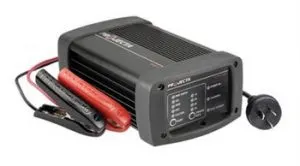 When you have access to mains power, you can also recharge your AGM battery with an AC battery charger. You just plug the charger into the power point and connect it up to the battery.
When you have access to mains power, you can also recharge your AGM battery with an AC battery charger. You just plug the charger into the power point and connect it up to the battery.
Battery chargers come in different amp sizes, the larger the amps the quicker the battery will charge. For example, a 10A battery charger will take about 12 hours to recharge a 120Ah battery. Whereas a 20A battery charger will take 5 hours.
5. Powering your 12v devices
Anything that uses 12v can be plugged straight into the battery. This includes things like your portable fridge or lights.
Your caravan or camper trailer will most likely be wired so that you have 12v outlets that lead to your battery. But if not, you’ll need adaptors that are connected to the battery so that you can plug the cigarette lighter plug into the battery. The guys at MyGenerator.com.au have these battery boxes with all the plugs so that you don’t have to connect and disconnect any wires.
6. Using 240v devices – you need an inverter
There are other electronic equipment that doesn’t use 12v power, things like laptops, microwaves and toasters. They have the normal plug that you use in your house and run on 240v AC power.
In order to power these devices, you will need an inverter that will convert the 12v DC power of the battery, to 240v AC power for your devices.

The size of the inverter you buy, will depend on the power consumption of the devices you’re running (i.e. the watts). For example, charging a laptop uses less power than running a microwave, so you will need a bigger inverter if you’re planning to take a microwave with you.
Inverters
Phew, I think that’s it for now. Was that helpful to you? I hope so.
Now obviously, this is only the basics of battery power for camping. It’s not enough information for you to go out and buy a new set-up, but hopefully it’s enough so that you’re not bamboozled when you go into the shop. And you can feel a bit more confident that what the salesman is selling you is indeed what you need.
To those that do know what you’re talking about, please do let me know if I’ve missed anything important or have led people down the garden path. (But nicely, I’ve only just learnt all this stuff too. :-))
Pin ‘Battery Power for Camping’ to Pinterest



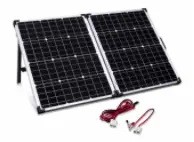

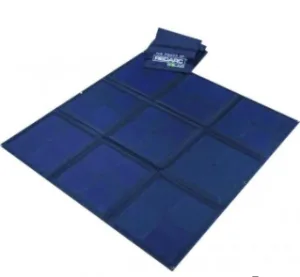

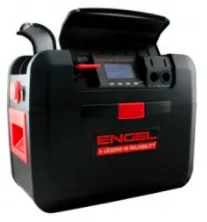
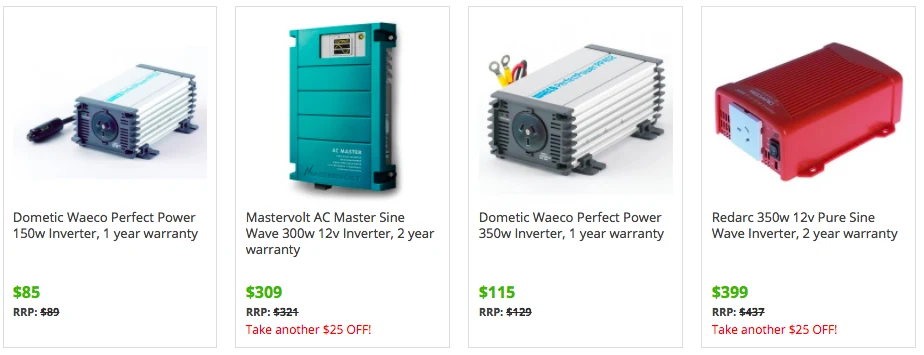
Pauline
Sunday 15th of December 2019
Hi Michelle
Nice write up for a novice:))
I am on my 2nd campervan the first I had gel batteries 4 x 64Ah. Problem with gel you can only dry down 50% takes ages to charge This time I have a 200Ah lithium battery with 12V fridge, 12v HWU with 500w solar. Going to get a 100w more as I have the room. Lithium you can drain battery down to 20% takes 1 hour to charge. Lithium battery expensive well worth the extra $$ Happy travels ✌
Michelle
Monday 16th of December 2019
Yeah, I definitely think lithium is the way to go! Sounds like you've got a great set-up going now. :-)
Birdie
Wednesday 8th of August 2018
Thank you for all that. I have a brother who does all my battery/electrical stuff, but its my caravan and I should know the basics. I have an 1974 Capricorn that I bought about four years ago, renovated and have done 6000Ks so far. Heading north next week to escape this winter chill.
Michelle
Saturday 11th of August 2018
Oooh, I just had to look up the Capricorn and it's the caravan of my childhood! Such a classic shape and I bet they're built tough too. Yeah, I thought I'd better educate myself on the whole battery/electricity stuff, but I'm finding the more I learn, the more confused I get! That's why I'm just going to stick to the basics and let the pros do their stuff. Michelle :-)